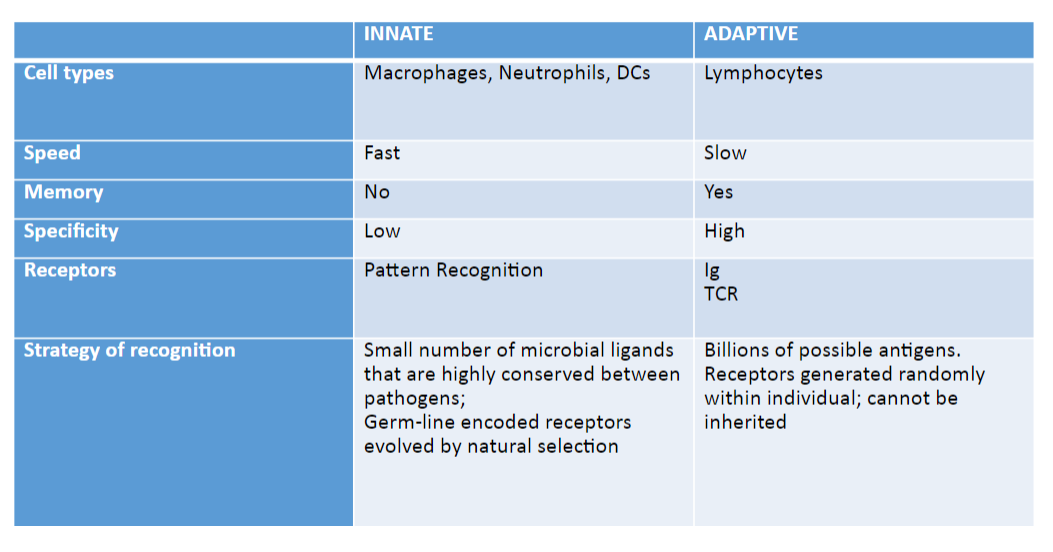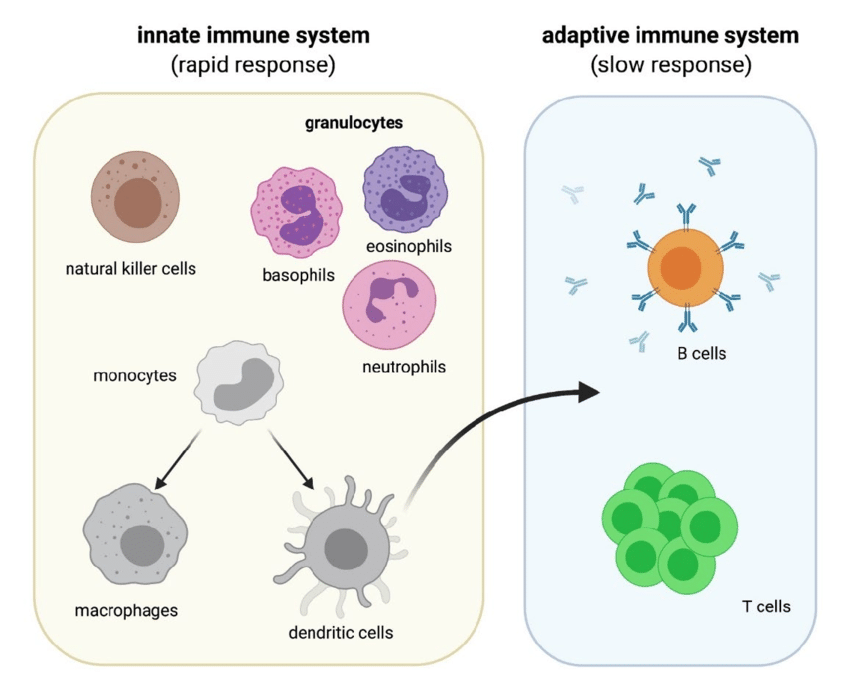
Innate Immunity (Pathology)
Topics covered: The basic components of the innate immune response Recognition; Pathogen-Associated Molecular Patterns (PAMPs) and Pattern Recognition Receptors (PRRs) Comparison and links between innate and adaptive immune system Defects in innate immunity mechanisms - connections with disease
-
Innate Immunity - what is it and why dowe need it? (5)
• It is a protective response to pathogens that does not require any previous exposure to the pathogen in question
• It is rapid
• It is relatively non-specific - it depends upon the recognition of conserved/invariant features of pathogens
• It utilises germ line-encoded host receptors
• It does not generate memory
-
STATEMENT: Resolution of infection requires bothadaptive and innate immune responses
Is this true or false?
TRUE
-
What is a PAMP? (Definition, examples and function)
PAMPs (Pathogen-Associated Molecular Patterns):
Definition: PAMPs are molecular motifs or patterns that are conserved within a class of microbes but are not present in the host organism.
Examples: Glycans, lipopolysaccharides, bacterial flagellin, lipoteichoic acid, peptidoglycan, and nucleic acid variants associated with viruses (e.g., double-stranded RNA).
Function: PAMPs are recognized by Pattern Recognition Receptors (PRRs) on immune cells, triggering immune responses. They act as signals indicating the presence of potential pathogens.
-
What is a DAMP? (Definition, examples and function)
DAMPs (Pathogen-Associated Molecular Patterns):
Definition: Damage-Associated Molecular Patterns (DAMPs) are endogenous molecules that are typically sequestered within cells.
Example: One example of a DAMP is High Mobility Group Box 1 (HMGB1). HMGB1 is a nuclear protein that is normally present inside cells, where it functions in the regulation of DNA structure.
Function of DAMPs: DAMPs are like alarm signals released by damaged or stressed cells. When cells are in trouble (due to injury, infection, or stress), DAMPs act as signals to alert the immune system. Their main jobs are to kick-start inflammation, which helps the body get rid of damaged cells, and to promote the repair of tissues. DAMPs essentially guide the immune system to areas where there's a problem, ensuring a quick and targeted response to potential threats.
-
What is gram-positive bacteria? (Describe cell wall structure, Staining reaction, outer membrane and some examples)
Gram-positive bacteria:
Cell Wall Structure: Gram-positive bacteria have a thick layer of peptidoglycan in their cell walls. Peptidoglycan is a complex molecule made of sugars and amino acids.
Staining Reaction: When subjected to the Gram staining process, Gram-positive bacteria retain the crystal violet dye and appear purple under a microscope.
Outer Membrane: Gram-positive bacteria lack an outer membrane outside the peptidoglycan layer.
Examples of Gram-positive bacteria include Staphylococcus, Streptococcus, and Clostridium.
-
What is gram-negative bacteria? (Describe cell wall structure, Staining reaction, outer membrane and some examples)
Gram-negative bacteria:
Cell Wall Structure: Gram-negative bacteria have a thinner layer of peptidoglycan in their cell walls, and they also have an outer membrane outside the peptidoglycan layer. This outer membrane contains lipopolysaccharides (LPS).
Staining Reaction: During Gram staining, Gram-negative bacteria do not retain the crystal violet dye well and appear pink or red under a microscope.
Outer Membrane: Gram-negative bacteria possess an outer membrane, which is not present in Gram-positive bacteria.
Examples of Gram-negative bacteria include Escherichia coli (E. coli), Salmonella, and Pseudomonas.
-
What are Pattern recognition receptors (PRRs)
Pattern recognition receptors (PRRs)• Host factors that specifically recognise a particulartype of PAMP• They are germ-line encoded• There are several classes of PRR, but functionally theyare either:• Extracellular – they recognise PAMPs outside of a cell andtrigger a co-ordinated response to the pathogen• Intracellular (cytoplasmic) – they recognise PAMPs inside acell and act to co-ordinate a response to the pathogen• Secreted – they act to tag circulating pathogens forelimination (e.g. complement)
-
What are the 5 main components of innate immunity?
• Phagocytes– Monocytes/granulocytes/neutrophils• Cytokines/chemokines• The inflammatory response• Complement• Natural Killer cells
-
How do Phagocytes know what to eat?
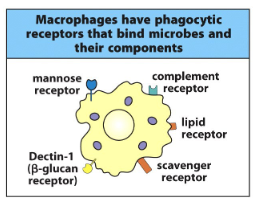
• Material to be “eaten” is recognised in a number ofways:• By detecting phosphatidylserine on exterior membranesurface (cells undergoing apoptosis)• By detecting “atypical sugars” (e.g. mannose, fucose, b-glucan) on cell surfaces• By detecting complement proteins bound to thepathogen surface• By Scavenger receptors• By “passive sampling
-
Glycoprotein hormones that affect the immune response.... which include what 2 molecules?
Cytokines and Chemokines
-
What are cytokines? (Definition, functions and examples)
Cytokines:
Definition: Cytokines are like messenger proteins that cells use to talk to each other.
Functions: They help cells in the immune system communicate and coordinate their actions. Some cytokines promote inflammation, while others calm it down.
Examples: Interleukins, interferons, tumour necrosis factors (TNF), and growth factors.
-In simple terms, cytokines help cells in the immune system communicate, while chemokines guide immune cells to where they're needed in the body. Both are crucial for a healthy immune response.
-
What are chemokines? (Definition, functions and examples)
Chemokines:
Definition: Chemokines are a specific type of cytokine that acts like a GPS, guiding immune cells to where they're needed in the body.
Functions: They attract immune cells to places with infections, inflammation, or injuries, helping the body fight off threats.
Examples: MCP-1, IL-8, RANTES.
-In simple terms, cytokines help cells in the immune system communicate, while chemokines guide immune cells to where they're needed in the body. Both are crucial for a healthy immune response.
-
PAMPs are recognised by a distinct group ofPattern Recognition Receptors
A picture outlining these receptors with their corresponding ligands and outcomes:
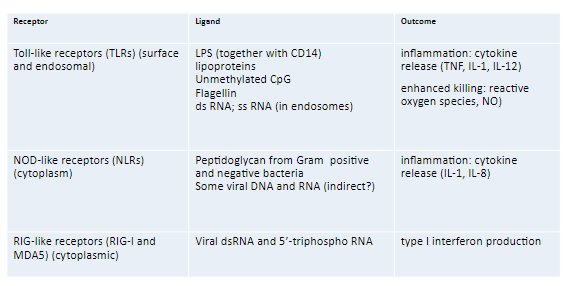
-
FILL IN THE BLANKS:
• Triggered by the release of _________ _________and _________ at the site of infection• A generic defence mechanism whose purpose is to _________ and _________ injurious agents and toremove _________ _________ components• Enhanced permeability and extravasation• _________ recruitment• Enhanced _________ _________• Enhance _________
The Inflammatory Response
• Triggered by the release of pro-inflammatorycytokines and chemokines at the site of infection• A generic defence mechanism whose purpose is tolocalize and eliminate injurious agents and toremove damaged tissue components• Enhanced permeability and extravasation• Neutrophil recruitment• Enhanced cell adhesion• Enhance clotting
-
What is complement?
-A system of secreted proteins (these are PRRs/pattern recognition receptors) made in theliver that recognise PAMPs on the surface of microbes and“decorate” or “tag” them.
-The microbes are then cleared byphagocytosis, “opsonised” or they have holes punched in them
-
What are the 3 ways of activating the complement?
Three ways of activating:
(i). Recognition of LPS and other PAMPs by the C1q component of “classical” pathway
(ii). Non-host glycosylation is recognised by MBP and otherlectins to activate the “lectin” pathway
(iii). Membranes that are recognised as “non-self” activate the “alternative” pathway
-
Complement activation involves a what cascade?
Proteolytic
-
State some information about Natural Killer (NK) cells(Large granular lymphocytes) (4)
Natural Killer (NK) cells(Large granular lymphocytes):
• Makes up 4% of white blood cells• Lymphocyte-like but larger withgranular cytoplasm• Kill certain tumour & virallyinfected cells• Target cell destruction is caused bycytotoxic molecules calledgranzymes & perforins
-
Natural Killer (NK) cells are activated by loss-of-self;
Describe this process

• NK cells possess the ability to recognise and lyse virallyinfected cells and certain tumour cells.• Selectivity is conferred by LOSS of "self" MHC moleculeson target cell surfaces, AND up-regulation of activatingligands
-
Picture outlining the interferon system:
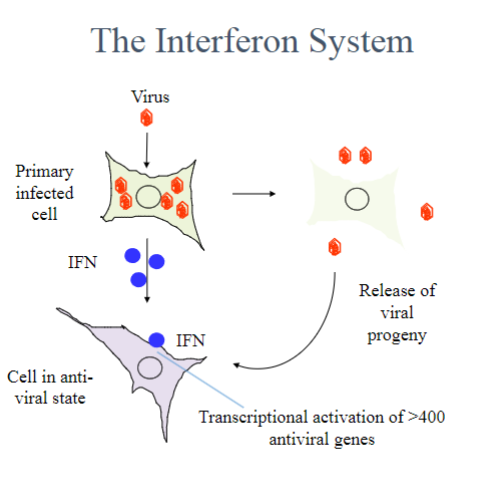
-
There are many diseases associated with inherited defects in Innate Immunity
State these 6 defects and their corresponding diseases:
• Complement – core defects (e.g. C3) linked to development ofautoimmune diseases such as lupus• Complement – non-core defects linked to susceptibility tospecific types of pathogens such as Neisseria• Macrophage deficiencies - Chronic granulomatous disease(CGD); No oxidative burst for bacterial killing• Macrophage deficiencies – IRF8 mutations linked tosusceptibility to TB• Aicardi–Goutières syndrome associated with constitutiveproduction of inflammatory cytokines• Lack of interferon-responsiveness – sensitivity to viralinfection (e.g. measles)
-
Picture Comparison of innate and adaptiveimmunity
